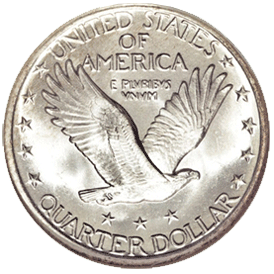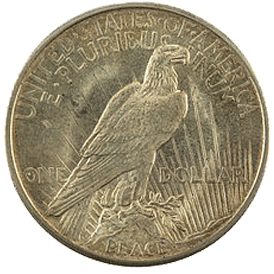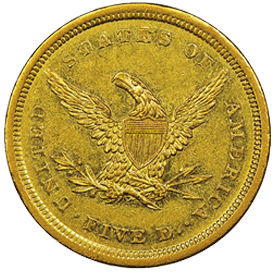Clash of the Coins
SYMBOLS
Triumphant George Token
Move your cursor over the coin or tap it on your screen to see the reverse side.


- These early U.S. coins are of British origin, most likely from Birmingham, England. They were designed to commemorate the end of the American Revolution. Some sources indicate that the head of the coin was intended to be either King George III or General George Washington. The laurel-wreathed George was in the style of King George III's Irish halfpenny image.
- Historians believe these coins, circulated during the period of the Confederation in Georgia and Virginia, were intended to display patriotism and signify the new states' unity.
- The coins were generally struck later than the dates shown on the coins. Some were struck after 1815 and circulated in the United States well into the mid-1800s.
- The reverse of the coin features an allegorical female figure who perhaps represents Liberty but is similar to Britannia. The figure holds an olive branch in her right hand and a staff in her left. If it is intended to represent Britannia, she would be holding a trident. Liberty's staff traditionally includes a cap on top of her staff. The female figure represented on this coin stands behinds 13 columns with a fleur-de-lis, a traditional French symbol, in each corner. This symbolized the 13 united colonies and the French financial support that contributed to the colonists' victory in the American Revolution. The motto, Voce Popoli, translates to "By the Voice of the People."
SYMBOLS
Fugio Cent (Franklin Cent)
Move your cursor over the coin or tap it on your screen to see the reverse side.


- In 1787, this became the first coin issued by the U.S. Congress, according to the Journal of Congress. Abel Buel of New Haven, Connecticut, created the dies used to strike the coins.
- The copper used to strike the coins was from U.S. military supplies, from the bands used to hold together powder kegs that the French government sent to the United States during the American Revolution.
- Featured on the front, or obverse, is a sundial that represents time and a motto popularized by Benjamin Franklin: "Mind Your Business."
- The back, or reverse, features 13 linked circles symbolizing the original 13 colonies with the words "United States" encircling the center motto, "We Are One."
SYMBOLS
Liberty Head V Nickel with No Cents
Move your cursor over the coin or tap it on your screen to see the reverse side.


- This coin was first issued in 1883. The reverse originally showed a large Roman numeral V (five) encircled by a wreath of corn, cotton, and wheat.
- The first coins issued were missing the word "cents."
- Fraudsters soon realized they could spend gold-plated versions of these five-cent coins with store owners who unknowingly accepted them as five-dollar gold pieces. Once the fraud was uncovered later in 1883, the word "cents" was added to the reverse.
- Charles E. Barber designed the coin, basing the Liberty head on a Greco-Roman marble sculpture. Liberty wears a crown bearing the word "Liberty" and is surrounded by 13 stars representing the 13 original colonies.
SYMBOLS
Standing Liberty Quarter
Move your cursor over the coin or tap it on your screen to see the reverse side.


- Herman A. MacNeil's original design of this coin included a bare-breasted Liberty, which called for a redesign. MacNeil cloaked the newly redesigned Liberty in a coat of mail covered by her flowing dress.
- The front, or obverse, features Liberty holding the olive branch of peace in her right hand and a shield with rivets in her left. Two rows of stars, representing the original 13 colonies, bracket her lower body.
- The obverse also includes 13 stars, along with the motto "In God We Trust."
- The reverse features the eagle partly surrounded by 13 stars, representing the original 13 colonies. The motto "E Pluribus Unum," which means "Out of Many, One," appears between the eagle's wings.
ARTISTRY
Saint Gaudens $20 Double Eagle Gold Piece
Move your cursor over the coin or tap it on your screen to see the reverse side.


- In 1904, President Theodore Roosevelt commissioned his friend, the renowned American sculptor Augustus Saint-Gaudens, to create new, more aesthetically pleasing American coins. Roosevelt especially liked the high-relief gold coins of ancient Greece.
- The obverse, or front, of the coin features Liberty. Saint-Gaudens modeled her after the famous Greek sculpture Nike of Samothrace. Liberty strides forward bearing the torch of enlightenment in her right hand and the olive branch of peace in her left. The rising sun and the U.S. Capitol are in the background.
- An eagle flies over a rising sun on the back, or reverse, of the coin.
- Charles E. Barber, the U.S. Mint's chief engraver, completed Saint-Gaudens's designs of the eagle and double eagle coins after the sculptor's death in 1907.
ARTISTRY
Flowing Hair Silver Dollar
Move your cursor over the coin or tap it on your screen to see the reverse side.


- Authorized by the Coinage Act of 1792, this was the first dollar the U.S. government issued.
- The flowing-hair design appeared in 1794 and was replaced in October 1795 with the draped-bust design.
- Designed by Robert Scot, a renowned engraver, this coin included a bust of Liberty on the front, or obverse, with an eagle on the back, or reverse, as required by the 1792 Coinage Act.
- Engraver Robert Scot modeled the bust of Liberty after his design for the one-cent coin. However, for the flowing-hair dollar coin, Scot removed the Phrygian cap, and government officials instructed him to encircle the eagle with a wreath.
ARTISTRY
Peace Dollar
Move your cursor over the coin or tap it on your screen to see the reverse side.


- The 1921 Peace dollar was first issued in January 1922.
- Slightly more than a million of these coins were struck.
- Peace dollars were struck at the Philadelphia Mint only in 1921.
- Struck in very high relief, the 1921 Peace dollar is one of the scarcest of the series because that was the only year the coins were struck in high relief.
ARTISTRY
Mercury Dime
Move your cursor over the coin or tap it on your screen to see the reverse side.


- Also called the Winged Liberty Head dime, this 10-cent coin was designed by Adolph Weinman.
- The obverse, or front, depicts Liberty wearing the Phrygian cap, which symbolizes freedom of thought. People mistakenly thought the design depicted the Roman messenger god, Mercury.
- Coin experts consider this coin one of the most aesthetically pleasing because of its intricate design on a small coin.
- The reverse, or back, features the fasces, the ancient symbol of authority, surrounded by the olive branch of peace. Upon its minting in 1916—the height of World War I—the desire for peace was strong.
HISTORY
Spanish Milled Dollar
Move your cursor over the coin or tap it on your screen to see the reverse side.


- In 1535, Spain opened a mint in Mexico, followed by other mints in Latin America, that produced Spanish dollars. These coins were also called pesos, a unit of weight.
- Queen Anne's Proclamation of 1704 made the Spanish dollar a monetary unit in the American colonies, worth six shillings.
- In the Coinage Act of 1792, Congress used the Spanish milled dollar as the basis of the American system of gold, silver, and copper coins.
- The Coinage Act of 1857 ended the use of the Spanish dollar, and all other foreign coins, as legal tender in the United States.
HISTORY
Bechtler $5 Gold Coin
Move your cursor over the coin or tap it on your screen to see the reverse side.


- Christopher Bechtler, along with his son August and his nephew Christopher, ran a private mint in Rutherford, North Carolina. Rutherford was a primary source of American gold from 1790 to 1840.
- In 1832, the Bechtlers produced the first gold one-dollar coin in the United States.
- The Bechtlers produced three denominations of coins: $1, $2.50, and $5.
- In 1834, the weight of the $5 gold coin changed. The Treasury Secretary ordered that the lighter coins be marked with the date August 1, 1834.
HISTORY
Steel Penny
Move your cursor over the coin or tap it on your screen to see the reverse side.


- In December 1942, Congress approved a one-cent coin that would conserve copper. The Mint selected zinc-coated steel as the substitute material.
- Steel penny production saved enough copper to manufacture 1.25 million shells for American big-field guns during wartime.
- The 1943 steel penny is the only regular American coin that a magnet can pick up.
- About 40 copper pennies were minted in 1943, when copper blanks were accidentally left in the production hopper.
HISTORY
Susan B. Anthony Dollar
Move your cursor over the coin or tap it on your screen to see the reverse side.


- The Susan B. Anthony dollar was first issued by the U.S. Mint in 1979. It was the first time a woman other than an allegorical female appeared on a circulating coin.
- The back, or reverse, features an American eagle landing on the moon. The image was adapted from the Apollo 11 insignia.
- The coins were originally minted only from 1979 to 1981, but a 1999 series was minted to meet demand for dollar coins before the Sacagawea dollar coins were issued in 2000.
- Upon signing the legislation authorizing the Susan B. Anthony dollar, President Jimmy Carter said the coin would "be a constant reminder of the continuing struggle for the equality of all Americans."
ECONOMIC ROLE
Willow Tree
Move your cursor over the coin or tap it on your screen to see the reverse side.


- The coins were minted in Boston in the 1650s under the direction of a mint-master named John Hull and his assistant, Robert Sanderson.
- The General Court of Massachusetts authorized the minting of coins in response to the persistent shortage of coins. Trade with England, France, and Holland—the source of circulating coinage—had caused most coins to flow from the colonies to Europe. The shortage was exacerbated during the English Civil War in the 1650s which led to a disruption in the flow of newly minted coins from England to the colonies thus compelling the leaders of the Massachusetts Bay Colony to devise their own solution.
- The simplistic design of John Hull's early coins made them easy to counterfeit. Adding the willow, oak, and pine tree designs to the series was intended to discourage counterfeiting.
- Scholars believe these coins were cold-struck with a hand-held hammer. This explains their inconsistent quality and multiple impressions on the surviving Willow Tree coins.
ECONOMIC ROLE
Half Disme
Move your cursor over the coin or tap it on your screen to see the reverse side.


- Around 1,700 to 1,800 of these coins—called the Half Disme (pronounced "deem")—were struck in July 1792. They have a face value of five cents and were mostly made of silver with traces of copper.
- The U.S. Mint does not consider these to be the first circulating coins under the U.S. Coinage Act of 1792 even though some did make it into circulation. They were minted in the private facilities of a Philadelphia craftsman, John Harper, since the Mint's official building had not been acquired.
- A congressional resolution, passed March 3, 1791, gave President George Washington the authority to order the minting of this coin.
- Secretary of State Thomas Jefferson provided most of the silver bullion used to mint the coins.
ECONOMIC ROLE
Templeton Reid 2.50 Gold Coin
Move your cursor over the coin or tap it on your screen to see the reverse side.


- The first private gold coin struck in the United States, it was struck by a jeweler and gunsmith named Templeton Reid.
- In 1830, the Constitution legalized private citizens' minting of coins.
- In July 1830, Reid moved from Milledgeville to Gainesville, Georgia, to be near the gold mines. He advertised in the local paper that he would mint coins in three denominations: $2.50, $5, and $10. Most of the 1,500 gold coins he struck were $2.50.
- The obverse, or front, was stamped “Georgia Gold” around the perimeter and the date—1830—in the center. The reverse, or back, of his coins was stamped T. Reid Assayer with the denomination in the center. Reid's mint in north Georgia was short lived, closing in 1831.
ECONOMIC ROLE
Dahlonega Mint Half Eagle Gold Coin
Move your cursor over the coin or tap it on your screen to see the reverse side.


- Gold was discovered in north Georgia in 1828, and a gold rush ensued by 1829. Private jewelers and metalsmiths minted coins in response to the demand for coinage until Congress passed and President Andrew Jackson signed legislation in March 1835 authorizing the creation of three mints in Charlotte, North Carolina; Dahlonega, Georgia; and New Orleans, Louisiana.
- The Dahlonega and Charlotte mints produced only gold coins. New Orleans minted both gold and silver coins. By the 1850s, the gold deposited for minting in Dahlonega came mostly from miners returning from California.
- The Dahlonega Mint operated from 1838 to 1861 and produced denominations of $1, $2.50, $3, and $5.
- The half eagle was a $5 coin.



